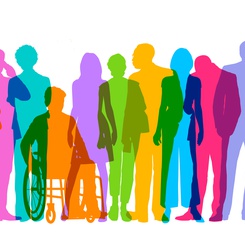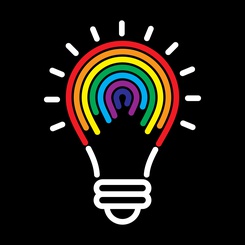In an ongoing research project, we investigate the strategies used by young LGBTQ* graduates to navigate the job search process. We collected data through in-depth interviews with LGBTQ Masters in Management students who are on the job market and who have previous work experience and with recent LGBTQ graduates of the Master’s program. Similar to other invisible diversity groups, the LGBTQ population is difficult to identify. We relied on our own formal and informal networks to identify current and recent graduates from the LGBTQ community.
This study is based on the observation that non-heteronormative individuals constitute an often invisible minority, one that is subject to inequalities in the workplace. Recent studies show that the workplace continues to be a complex environment for LGBTQ employees as most firms are embedded in heteronormative assumptions and expectations which are maintained and developed through everyday interactions (1,2,3,4,5). Each diversity category has its particular characteristics. The LGBTQ community assembles all non-heteronormative populations, making it extremely diverse within the community*. In addition, unlike gender or race, it is an often invisible difference*** and individuals have the choice to be “out” or not. As an invisible minority, LGBTQ employees are often faced with deciding what aspects of their private lives to share at work and with whom within this heteronormative context. Studies indicate that “coming out” at work has positive psychological consequences compared to “staying in the closet” (6), and concealing a stigmatized identity (e.g. LGBTQ) reduces feelings of belongingness, self-esteem, job satisfaction and job commitment (7).
However, there is still a large proportion of LGBTQ employees who choose not to come out in the workplace, and reported incidents of workplace discrimination and microaggressions continue to abound. Research on LGBTQ professionals reveal that they were more likely to experience career limitations, harassment, and professional devaluation than their non-LGBTQ counterparts. These professionals also experience more health difficulties and are more likely to leave their workplace due to the psychological consequences of microaggressions and other discriminatory experiences. There is a clear impact of LGBTQ identity on employee well-being and on organizational outcomes such as turnover and performance.
In our study, we investigate how recent LGBTQ graduates of a Masters in Management program in France narrate their transition into becoming young professionals, and the role of their LGBTQ identity in this process. The identity literature has highlighted transition moments as key triggering moments for identity processes. The literature focuses on how individuals develop and maintain or change narratives of the self through an interaction between internal visions of the self and external influences. There is a paucity of literature on the transition processes of LGBTQ professionals, including their apprehensions in their transitions from university students to working professionals. This is a transition moment when graduating students are concerned about entering the workforce and leaving university, the coming-out process, and finding support in their new work environment. For young LGBTQ graduates, gender identity and sexual orientation is an additional identity to negotiate and manage in the transition process and in the new professional environment.
We found that during the job search process, the LGBTQ identity may not be seen as important for these individuals if they had other, more salient identities. Many of our interviewees were also international students, and a recurrent theme in their narrative was the activation of their “international” or non-local identity as a major source of difficulty in their job search process. For many, the language difficulties encountered in the job search process and also later on the job overruled their LGBTQ identity, so that many did not feel that the latter played a role in their professional interactions.
According to social identity theory, the saliency of a particular identity depends on the importance and relevance of that identity for the individual and their environment. Our international respondents felt that perceived lack of competency in the local language was a major identity trigger for them and for firms. We also found that when there are other compounding identities that are actively triggered by the situation, the LGBTQ identity takes a back seat and is not something that is either activated by the individual or perceived by their environment.
However, respondents who already had experience in several employment situations, for example through internships or short-term contracts, felt that finding a diversity-friendly work environment was important to them. Most had experiences with hostile work environments where their LGBTQ identity had become salient for them and they reported not feeling comfortable, having to hide their LGBTQ identity, and experienced various levels of isolation.
For these respondents, actively hiding their LGBTQ identity constitutes a form of identity work. The main characteristics of identity work are that it is a discursive process instigated by the individual in which the individual has an agentic role in the process of self-definition and which may involve identity elements that reside within the individual as well as identity elements that are present in their social environment. For example, Sveningsson and Alvesson note that individuals are continually "engaged in forming, repairing, maintaining, strengthening or revising the constructions that are productive of a sense of coherence and distinctiveness" (8), thus emphasizing the role of agency in the discursive process of self-definition. In the case of LGBTQ individuals in hostile work environments, the identity work involves noticing conforming to external identity elements to avoid potentially harmful consequences. Our respondents who had experienced such environments were unable to benefit from the positive outcomes of identity work, and not being able to generate a sense of coherence with their work environment, consequently left in search of more LGBTQ-friendly workplaces.
For respondents who already had some work experience, and who were looking for LGBTQ-friendly work environments, an obvious choice was to approach firms that already had progressive LGBTQ policies. At the same time, they were also open to other possibilities, and in order to “test” the different work environments, respondents mentioned several strategies to signal their interest in LGBTQ issues to potential recruiters. One respondent told us that he had put his affiliations with LGBTQ-support associations on his LinkedIn page for recruiters to see. Others had put similar types of information on their CV for recruiters to see. While they were not technically ‘coming out’ in these instances, they used these strategies to test the waters to see if they would be called back or not. As one respondent put it: “ ..this way the ball is in their court. I put the information out there and if I get called back, I take it that they are ok with that.”
Another strategy for managing and negotiating LGBTQ identities once employed was "don’t ask, don’t tell". This is related to "coming out" strategies in the workplace. One respondent who did not think that their LGBTQ identity was relevant to their work applied a strategy only shared information about their gender identity and sexual orientation when asked directly. Another respondent also told us that they mentioned their LGBTQ affiliation if it came up in the conversation.
We observed a conservative approach to "coming out" in the workplace among our respondents. Their initial reaction was to say that their LGBTQ identity was not relevant to the work that they do, so there was no need to reveal it. At the same time, one respondent mentioned that in one workplace that they had immediately felt was "open", they had come out to their colleagues in the second week at work. Despite their reticence, we observed that the work environment is extremely important in their choice to share that information.
Many of our respondents discussed when it was meaningful to come out at work, and to whom. They all agreed that it was not necessary to reveal their LGBTQ identity to everyone at work. Rather, what was important was to have good relations with close colleagues and teammates with whom they had high-volume, high-density interactions. These were the people with whom they were more likely to discuss not only work-related matters, but also non-work subjects where personal information is more likely to be shared.
All our interviewees clearly delineated the LGBTQ identity as belonging to the private, personal sphere and thus not directly salient in the workplace. As such, we observed that they were generally discreet regarding when to “come out”, to whom and how in the job search process and once on the job. At the same time, they were keen to find work environments that were open and diverse, and in such workspaces, it was relatively easy and meaningful to open up about their LGBTQ identity. Even so, it was evident that they “came out” only to a specific group of people – those with whom they had high-volume and high-density interactions. In this particular context, sharing personal information was perceived as useful to working effectively in the team.
For our respondents, identifying the core group of work colleagues with whom to share their LGBTQ identities so as to generate an inclusive group is key to their "coming out" strategy. Those who have succeeded in doing this report positive outcomes for themselves and their immediate team, such as feeling of self-enhancement, common membership and consequently team solidarity and trust in the team.
References
-
Cech, EA, and Waidzunas, TJ (2021) Systemic inequalities for LGBTQ professionals in STEM. Science Advances, 7:1-9.
-
Coffman, KB., Coffman, LC., and Ericson, KMM. (2017). The size of the LGBT population and the magnitude of antigay sentiment are substantially underestimated. Management Science, 63(10):3168-3186.
-
McFadden, C. (2015). Lesbian, gay, bisexual and transgender careers and human resource development. Human Resource Development Review, 14, 125–162.
-
Rumens, N. (2010). Firm friends: Exploring the supportive components in gay men’s workplace friendships. The Sociological Review, 58, 135–155.
-
Subharwal, M., Levine, H., D’Agostino, M. and Nguyen, T. (2019). Inclusive Work Practices: Turnover Intentions Among LGBT Employees of the U.S. Federal Government. American Review of Public Administration, 49(4):482-494.
-
Madera, J. M. (2010). The cognitive effects of hiding one’s homosexuality in the workplace. Industrial and Organizational Psychology: Perspectives on Science and Practice, 3, 86–89.
-
Newheiser, AK, Barreto, M., and Tiemersma, J. (2017) People like don’t belong here: Identity concealment is associated with negative workplace experiences. Journal of Social Issues, 73(2):341-358.
-
Sveningsson, S., & Alvesson, M. (2003). Managing Managerial Identities: Organizational Fragmentation, Discourse and Identity Struggle. Human Relations, 56(10), 1163–1193.
Footnotes
* Lesbian, Gay, Bisexual, Transgender, Queer
**This applies to other diversity categories as well, for example people with disabilities, but to a much lesser extent for gender, and race and ethnicity categories, although intersectionalities add complexity to these as well.
***This characteristic also applies to people with invisible disabilities, who experience the dilemma of reporting their disability (which is encouraged by firms in countries with disability quotas) or not, to avoid potential unequal treatment









